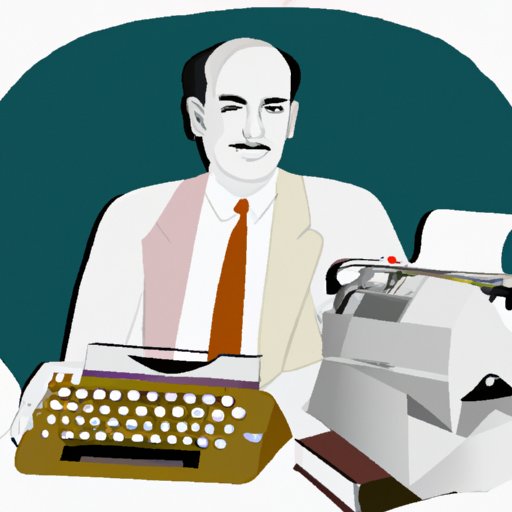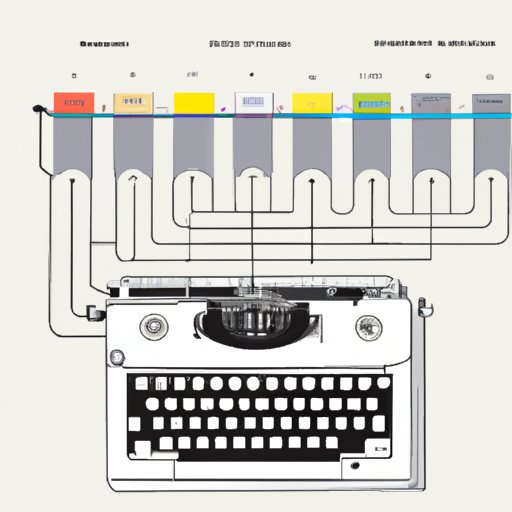Introduction
A typewriter is a mechanical or electromechanical device used to type characters onto paper. It was invented in the 19th century and has since been used as a tool for communication and writing. Understanding the history of the typewriter is important because it helps us appreciate how far we’ve come in terms of technology. From the early patent in 1714 to the introduction of the QWERTY keyboard in 1868, the typewriter has gone through various stages of evolution to become the device we know and use today.
A Historical Look at the Invention of the Typewriter
The first patent for the typewriter was issued in 1714 to Englishman Henry Mill. Although the machine was never built, it marked the beginning of the journey towards the invention of the typewriter. In the following decades, other inventors also attempted to create a working typewriter. One of the most notable inventors was Italian Pellegrino Turri, who created a typewriter for his blind lover Countess Carolina Fantoni da Fivizzano in 1808. The machine allowed her to write independently for the first time.
Early typewriters were not widely adopted until the mid-19th century, when their potential for commercial use had been recognized. In 1829, William Austin Burt created the first typewriter to be used commercially. His machine was called the “Typographer” and it was widely used by businesses and individuals alike. By the 1860s, typewriters had become common tools in many offices.
The Fascinating Story of How the Typewriter Came to Be
The development of the typewriter in the 19th century was largely driven by innovators such as Christopher Latham Sholes, Carlos Glidden, and James Densmore. Sholes is credited with creating the first practical typewriter, which he patented in 1868. He also introduced the QWERTY keyboard layout, which is still used in most keyboards today.
Sholes’ innovation was followed by other key inventions, such as the Remington No. 1, which was released in 1873 and was the first commercially successful typewriter. The Remington No. 2, released in 1878, featured a shift key that allowed users to type both upper and lowercase letters. This advancement led to the widespread adoption of the typewriter as a tool for both personal and business writing.

From Invention to Innovation: The Evolution of the Typewriter
The introduction of the QWERTY keyboard was a major milestone in the evolution of the typewriter. The keyboard was designed to reduce the likelihood of jamming when typing at high speeds, and it quickly became the industry standard. Further advancements in typewriter technology included the introduction of electric typewriters in the 1920s and the development of the IBM Selectric typewriter in 1961, which featured an interchangeable type ball for changing fonts.

How Typewriters Changed the Way We Communicate
The introduction of the typewriter revolutionized the way people communicated. Professional typists emerged as a result of the increased demand for typewritten documents. Typewriters also enabled the growth of the publishing industry, as they allowed books and newspapers to be printed quickly and efficiently.

The Inventor Who Revolutionized Writing with the Typewriter
Christopher Latham Sholes was a prolific inventor and journalist who is best known for his invention of the typewriter. He first patented a typewriter in 1867, but it wasn’t until 1868 that he developed the first practical version of the machine. His invention revolutionized the way people wrote and communicated, and it paved the way for further advancements in the field of communication.
Sholes’ legacy lives on today, as the typewriter continues to be an important tool for communication. His invention has helped shape the way we communicate and has enabled us to express ourselves in ways that were previously unimaginable.
A Timeline of the Typewriter: When Was It Invented?
1714 – The first patent for the typewriter is issued to Englishman Henry Mill.
1808 – Italian Pellegrino Turri creates a typewriter for his blind lover Countess Carolina Fantoni da Fivizzano.
1829 – William Austin Burt creates the first typewriter to be used commercially, called the “Typographer”.
1867 – Christopher Latham Sholes patents his first typewriter.
1868 – Sholes develops the first practical version of the typewriter and introduces the QWERTY keyboard.
1873 – The Remington No. 1 is released, becoming the first commercially successful typewriter.
1878 – The Remington No. 2 is released, featuring a shift key for typing both upper and lowercase letters.
1920s – Electric typewriters are introduced.
1961 – IBM releases the Selectric typewriter, featuring an interchangeable type ball for changing fonts.
Conclusion
The typewriter has come a long way since its invention in the 19th century. Thanks to the work of innovators like Christopher Latham Sholes, we now have access to a powerful tool for communication and writing. From the introduction of the QWERTY keyboard to the development of the IBM Selectric typewriter, the evolution of the typewriter has been an exciting journey. Today, we can appreciate the impact that the typewriter has had on modern communication and writing.
(Note: Is this article not meeting your expectations? Do you have knowledge or insights to share? Unlock new opportunities and expand your reach by joining our authors team. Click Registration to join us and share your expertise with our readers.)
